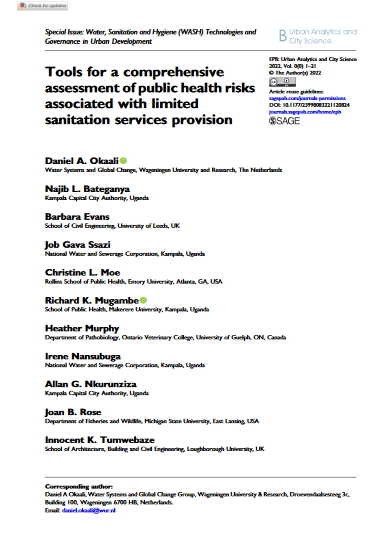Tools for a comprehensive assessment of public health risks associated with limited sanitation services provision
 |
article Aug 2022 ; 22 pages
Ed. Sage Journals -
Downloadable format: PdF
Downloadable from the publisher
Abstract:
Three water, sanitation and hygiene (WASH) support tools were applied to Kampala city, Uganda, to evaluate areas with the highest health hazard due to poor wastewater and faecal sludge management and to develop interventions to improve sanitation and reduce exposure. The Pathogen Flow and Mapping Tool (PFMT) assessed how different sanitation management interventions influence pathogen emissions to surface water using rotavirus as the indicator pathogen, while the HyCRISTAL health hazard tool evaluated how flooding and drainage infrastructure influence the presence of human excreta in the environment. The SaniPath tool identified common high-risk pathways of exposure to faecal contamination in food, open drains and floodwater. An overlap in high health hazard hotspot areas was identified by the PFMT and the HyCRISTAL tools. Across the city, the most important hazard sources were the indiscriminate disposal of faecal waste into open stormwater drains from onsite sanitation technologies, open defecation and the insufficient treatment of wastewater. The SaniPath tool identified drain water, floodwater, street food and uncooked produce as the dominant faecal exposure pathways for selected parishes in the city, demonstrating the presence of excreta in the environment. Together, the tools provide collective evidence guiding household, community, and city-wide sanitation, hygiene and infrastructure management interventions from a richer assessment than when a single tool is applied. For areas with high spatial risks, those practising open defecation, and for low-lying areas, these interventions include the provision of watertight pit latrines or septic tanks that are safely managed and regularly emptied. Faecal sludge should be emptied before flood events, direct connections of latrines to open storm drains should be prevented, and the safe handling of food and water promoted. The tools enhance decision making for local authorities, and the assessments can be replicated in other cities.
Keywords: |
access to sanitation (CI) (DT) (ET) (ope) , access to water (CI) (DT) (ET) (ope) , health (CI) (DT) (ET) (ope) , hygiene (CI) (DT) (ET) (ope) |
Country: |
Publisher/Broadcaster: |
|
Sage Journals - - United Kingdom |
If there is a broken link, we will be pleased to receive a message: communication@pseau.org